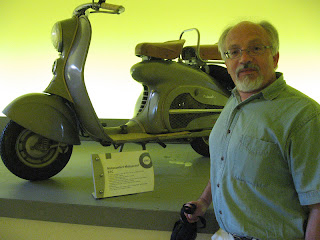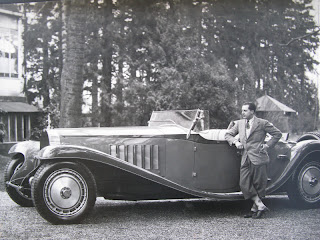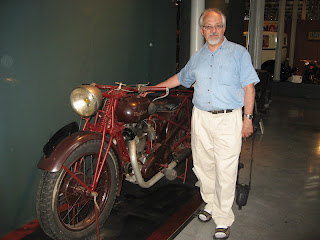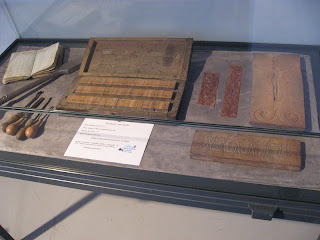This posting's for you, Gary. You would have loved touring this museum with us!
This museum is located in one of the buildings that used to be part of the National Weapons' Factory, established in 1819. It was a strategic site, well served by the historic road from Paris to Spain and the river Vienne. At first, swords were manufactured, then came the famous French rifles, such as the Lebel type.
Today, the Motor Museum has an impressive collection of cars, motorcycles and bicycles, or as they say in France: auto, moto et vélo.
In 1870, the first all-metal machine appeared and front wheels became larger and larger on the "Penny-farthing" or "Grand Bi".
While men were risking their necks on the high wheels, the ladies, hindered by their long skirts and corsets, could only take a spin around the park on an adult tricycle. These machines also afforded greater mobility to gentlemen such as doctors and clergymen.
 |
| Panhard and Levassor P2D, 1890 |

During WWI, the first motorized war in history, a lot of progress was made in transportation. The bicycle had an important place in the conflict.
 A big steam engine, which proved too bulky, too heavy, and too difficult to manage. No need for gas stations in the towns - just a huge supply of water. The horses had to be held back while the driver "filled up". A technology best left for a while, until the advent of steam engine trains.
A big steam engine, which proved too bulky, too heavy, and too difficult to manage. No need for gas stations in the towns - just a huge supply of water. The horses had to be held back while the driver "filled up". A technology best left for a while, until the advent of steam engine trains.
I'm sure I've seen this guy on TV. Isn't he the little engine that could? Or perhaps I'm thinking of Theodore the Tugboat.
Some of the first gas pumps.
 |
| Lathe |
This is a teeny, tiny car, more like a toy. But so cute! I want to adopt it and bring it home.
What was amazing with this museum is that they juxtaposed other items that would have been in the same time period, to give us a real overall sense of the setting. This is an early ice box.
 |
| Avions Voisin C14 Coach, 1929 |
After the deprivations of the war, a new desire for liberty and joy of living appeared in Europe in the 1920s. Luxury cars, such as the magnificent Avions Voisin C14, gained extensive facilities to improve passengers' comfort.
During the "Roaring Twenties", while Paris was the world capital of interior design and fashion, partnerships between artists and car makers gave birth to tailor-made vehicles.
"Marguerite, let me park this one in the garage, ok?"

"Or perhaps this one?"
Opportunities for picnics and leisure time! In France, with the first paid holidays established in 1936, personal transportation increased. The emergence of a genuinely working-class car, known as the Citroën 2CV, definitely started up automobile democratization in the 1950s. Scooters were also developed in those years, a wide range of French models including Bernardet and Paul Vallée.
Karl will accept any model of the Rolls...
 |
| Delahaye 135M, 1949 |
The 1930s gave way to important research in aerodynamics: new car shapes appeared with the streamlining movement. Although the crisis slowed down car democratization, this period used to be a golden age for French car designers. The grey Delahaye 135M remains a good example of the French know-how which used to be recognized worldwide.
The gas pump was changing.
As well as the garages.
Hoisting up a car was a new concept.
A kitchen and living room setting that doesn't seem from that long ago. I still remember avocado fridges and plastic kitchen chairs, big black & white TV consoles...

and Remington typewriters.
Wait a minute! I can't believe this scooter is very old since I could swear I've seen it racing through China and India, 6 people aboard and a few wicker cages of live "canards" flapping in the breeze! Or were they bolts of fabric...

Not much room to transport anything big on this one!
"Daisy, Daisy, give me your answer true. I'm half crazy, all for the love of you! It won't be a stylish marriage, I can't afford a carriage, But you'll look sweet, upon the seat, of a bicycle built for two!"

This scooter is a 1952 vintage model, much like the woman demonstrating its lovely features!
This car was driven by the person sitting in the back seat, and the passenger was seated in the front seat. For some reason, it got the nickname of "Tue belle-mère" (Death to the Mother-in-law).

The big front scoop could accommodate huge skirts and buttoned-up shoes.
 |
| Hood ornament |
Try this one out. You sit on the motorbike, but the one wheel goes round and round while you stay put. Karl wants this one too!

Those early mechanics' tool boxes!

People must have been awfully small to fit in these tiny machines. They were the early prototypes of electric cars. What's old is new again.
A futuristic look.
A sign, or signs, of the time! Yes, along with motorized transportation came rules and regulations.
 In a special section called the "Yellow Alley", there is an interesting 2-wheel collection, including the Pagnon prototype and the very rare Imme motorbike.
In a special section called the "Yellow Alley", there is an interesting 2-wheel collection, including the Pagnon prototype and the very rare Imme motorbike.Karl definitely wants a Rolls Royce parked in his garage! Any vintage year will do.

But then a Porsche wouldn't be so bad...
What about a fashionable British convertible of the 1960s: Triumph, MG, Sunbeam...
 |
| Bollée Family Tree |
An entire wing of the museum is dedicated to the Bollée family of Châtellerault, dating back to 1781. These generations of men began as itinerant bell makers but branched out into hydraulics, wind turbines, and cars.
Léon Bollée (1870 - 1913) invented an adding machine, a ticket dispenser and was instrumental in the progress of auto development. He won the Legion of Honour in 1901.
These are some of the early tools used in the making of bells.
 |
| Stages of bell making |
There is a beautiful set of carillons in the "Église Saint-Jacques de Châtellerault". Unfortunately, there were no concerts planned for the time period when we would be in the area.
Tsar Alexander III ordered 500,000 Mosin-Nagant guns to be manufactured, a boon for the area. In commemoration, the parishioners dedicated a special celebration to his memory in 1894. A huge Russian delegation were in attendance, and they promised a bell for the town, in appreciation of this commemoration.
The bell, made in St-Petersburg in the V.M. Orlow foundry, arrived in Châtellerault in 1897. One can see Tsars Alexander III, Nicolas II, as well as two French Presidents, Sadi Carnot and Félix Faure. The inscription: Sonnez la paix et la fraternité des peuples. (Ring peace and fraternity between peoples.)




















































Marguerite, I'm very honoured to have you dedicate this blog post to me. I love your blog, it's very well done and very well organized. It's extremely interesting and I feel like I'm visiting right along with you.
ReplyDeleteThese are wonderful memories to cherish and I'll keep enjoying your postings. Looking forward to the next one!
Enjoy your holiday, we miss you and look forward to seeing you when you both get home.
Gary